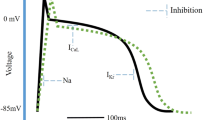Abstract
Several antiarrhythmic and non-cardiovascular drug therapies including antimicrobial agents have been implicated as the causes for QT interval prolongation, torsades de pointes (TdP) ventricular tachycardia and sudden cardiac death. Most of the drugs that have been associated with the lengthening of the QT interval or development of TdP can also block the rapidly activating component of the delayed rectifier potassium current (IKr) in the ventricular cardiomyocytes. This article presents a review of the current literature on the QT interval prolonging effect of antimicrobials based on the results of the in vitro, in vivo studies and case reports. Our observations were derived from currently available Medline database. As we found, the most frequently QT interval prolonging antimicrobials are erythromycin, clarithromycin, fluoroquinolones, halofantrine, and pentamidine. Almost every antimicrobial-associated QT interval prolongation occurs in patients with multiple risk factors of the following: drug interactions, female gender, advanced age, structural heart disease, genetic predisposition, and electrolyte abnormalities. In conclusion, physicians should avoid prescribing antimicrobials having QT prolonging potential for patients with multiple risk factors. Recognition and appropriate treatment of TdP are also indispensable.
Similar content being viewed by others
Author information
Authors and Affiliations
Corresponding author
Rights and permissions
About this article
Cite this article
Simkó, J., Csilek, A., Karászi, J. et al. Proarrhythmic Potential of Antimicrobial Agents. Infection 36, 194–206 (2008). https://doi.org/10.1007/s15010-007-7211-8
Received:
Accepted:
Published:
Issue Date:
DOI: https://doi.org/10.1007/s15010-007-7211-8



